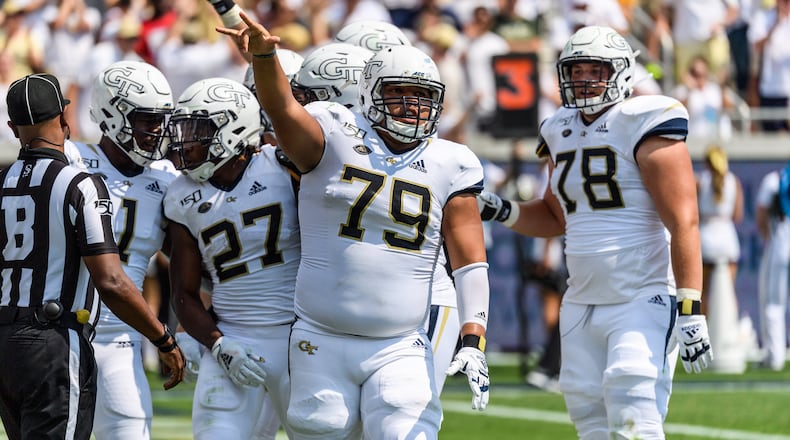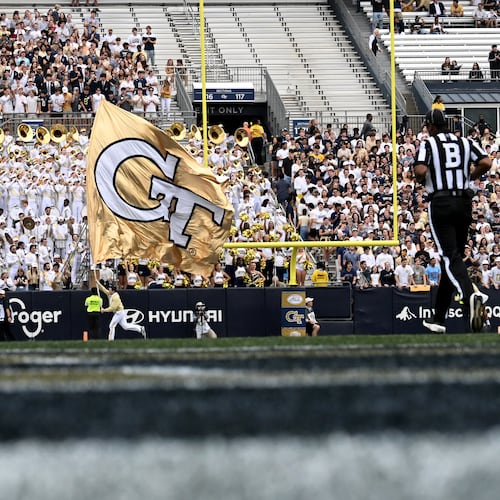When his new coaches arrived last January, Georgia Tech offensive tackle Zach Quinney was on board with their plan for him to eat as much as he could. Believe it or not, however, the gorging grew old.
“It is (difficult) and it’s not near as fun as it seems,” Quinney said. “It’s been a challenge for us. But with everybody holding each other accountable — like, if I just don’t feel like eating this — I know somebody behind me is like, Zach, come on, man. I know you’ve got to eat that. That’s really what’s helped us.”
So it is with the Yellow Jackets — teammates looking out for their friends by not letting them step away from the training table with anything less than a clean plate, or plates. It’s one manner by which Tech has tried to increase weight this offseason with the aim of becoming a bulkier roster, harder to dislodge on blocks and more effective in driving opponents out of the way.
“Once you’re full, you really don’t want to eat anymore,” Quinney said. “But, I don’t know, you understand what it’s going to do for you. That just helps you keep going and know why you’re doing and put on the weight that way.”
Speaking in recent days, prior to the ACC’s suspension of all athletics-related activities last Thursday due to the spread of COVID-19 — including Tech’s spring practice, after six sessions — Quinney, teammates and coaches had felt the impact of the team’s weight-gaining mission.
“That was a big deal for us,” defensive-line coach Larry Knight said. “Because when you’re double-teamed, the ability to put on the right type of weight has been huge for us, and it’s not just a pound of candy bars and whatever else in between, gaining fat weight. They’ve actually gained real weight, weight-room weight. And you can really see the difference.”
According to data collected by SportSource Analytics, the average weight of Tech’s 2018 team, which finished 7-6 in former coach Paul Johnson’s final season, was 115th in FBS. Strength and conditioning coach Lewis Caralla and his staff led a muscle- and weight-gaining program throughout coach Geoff Collins’ first season, but the team’s performance in its 3-9 season led Collins to challenge his team to gain an average of 10 pounds per player.
“Because we were outweighed, outmatched at a lot of positions,” he said in December.
Center William Lay said that the offensive line had gained an average of about 20 pounds per player, going back to Collins’ arrival. Lay was 280 at the time, finished the 2019 season at 300 and was at 308 as of last weekend.
“They check our breakfast, they check our dinners,” Lay said. “So, eating a lot, working out, making sure we’re getting our protein shakes afterward. Real strict weight plan. They’re always checking our weight, making sure we’re in our weight range and stuff.”
Rice has become a staple, he said, as well as proteins such as chicken and beef. Like Quinney, the challenge to keep eating has been real.
“For sure,” Lay said. “It comes to a point where you’ve got to push yourself to even eat.”
But, he said, he had felt the change in the first few days of spring practice. Lay said he “definitely feels stronger on the field, moving guys easier, controlling guys more in the pass (protection).”
Quinney was up to 305 pounds last weekend. He was at 293 at the start of last season and dipped to 290 by season’s end, he said. His 305 pounds were the most he had ever carried. He was at 262 on the first day of spring practice last year, offensive coordinator Dave Patenaude said.
The difference is felt, Quinney said, in “moving people in a way that I never really could, so it’s a great thing, for sure.”
Defensive coordinator Andrew Thacker highlighted the gains made by redshirt freshman linebacker Cornelius Evans, who has put on about 25 pounds — up to about 220 — from the time he arrived at Tech last summer. Thacker said that Evans “looks completely different” this spring compared to last fall as he has gone through linebacker drills.
“So really pleased with where he’s at,” Thacker said. “And then, as he continues to play more violently, he’s going to get more reps, too, with those older groups as well. So, excited about what he’ll be.”
Tech has gotten bigger, too, with the additions of players like early-enrollee freshman offensive tackle Jordan Williams (6-foot-6, 310 pounds) and grad-transfer guard Ryan Johnson (also 6-6, 310). While far more goes into performance than what the scale says, things tend to go better when those scales are in your favor.
“Big people move little people,” Patenaude said. “That’s just a basic principle of football. We look a lot different.”
Having more mass figures to help run and pass blocking both. For various reasons, including weight, Tech was inconsistent with both last year.
The Jackets also could use increased heft along the defensive line. Tech was 101st last season in yards-per-carry defense at 4.79 yards per attempt in part because of the Jackets’ lack of size and experience up the middle. Among others, defensive tackle JaQuon Griffin is up to 280 pounds from 270 since the end of last season.
“We didn’t look like this last spring, and it’s the same guys,” Knight said. “I think that’s going to help a lot.”
From a football perspective, the team’s time away from campus and practice could have a bearing on the weight gains that players have made. (By ACC decree, all competition and “formal and organized practice,” among other activities, have been suspended until further notice.)
Tech students have been asked to not return to campus until March 29. Given that, and the uncertainty regarding the ACC’s resumption of competition and practice, the remainder of Tech’s spring practice is unclear.
Without a training table and a supervised lifting program until players return to campus, the Jackets’ challenge to build on strength and weight gains, or even maintain them, would seem to elevate, particularly given the lengths to which players have gone to pack calories onto their diets.
But, undoubtedly, whenever Collins reconvenes his team next, a weigh-in would seem highly likely, to measure the retention of gains made over the past several months, squat by squat, bite by labored bite.
About the Author
Keep Reading
The Latest
Featured




